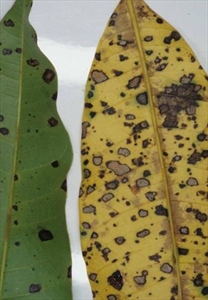Mango sooty blotch
Pacific Pests, Pathogens and Weeds - Online edition
Pacific Pests, Pathogens & Weeds
Mango sooty blotch (317)
Guignardia mangiferae; this is the sexual state of the fungus. The asexual state is recorded as Phyllosticta anacardiacearum and Phyllosticta capitalensis. Another disease also called sooty blotch has been reported from Australia (possibly) implicating the little known fungus Stomiopltis.
Asia, Africa, North, South and Central America, the Caribbean, Europe, Oceania. It is recorded from Cook Islands, Fiji, Niue, Papua New Guinea, Samoa, and Tonga.
Mango. It is recorded as a pathogen and an endophyte from a broad range of plants. An endophyte is a fungus, or a bacterium, that lives inside a plant without causing a disease.
An unimportant fungus affecting mango and causing leafspots. Often as a symptomless endophyte, i.e., growing inside plant tissues without causing a disease. Leaf spots on mango are known from North America (Miami), Brazil, Ghana, India, and Fiji.
The leaf spots occur on seedlings, circular or irregular, up to 5 mm diam., grey with a dark brown or black border. Only the asexual, Phyllosticta stage occurs in the leaf spots. The sexual, Guignardia stage, occurs on dead leaves. The fungus is spread in rain and wind.
In Australia, a fungus, possibly Stomiopeltis species, has been implicated in sooty blotch, causing "sparse superficial dark thread like fungal growth on shoot terminals (stems and leaf petioles), leaves, fruit stalks and sometimes on the fruit"1. There are also small, dark-brown blotches on leaves and young fruits. The disease occurs in most mango-growing areas, and it is favoured by rain, fog, irrigation and high humidity in warm weather, when spores are produced and infections occurs.
Both diseases known as sooty blotch - Guignardia mangiferae and (possibly) Stomiopltis cause minor diseases of little economic importance. They are controlled when trees are treated for anthracnose disease.
Look for the grey leaf spots with dark brown or black margins on leaves. Look for the black dots of the fruit bodies in the spots on the upper leaf surface.
There is no treatment suggested for this disease as it is of little or no economic importance.
AUTHORS Grahame Jackson & Eric McKenzie
Information from (and Photos 1&2) McKenzie E (2013) Guignardia mangiferae: PaDIL - (http://www.padil.gov.au); and from 1Chin D et al. (2010) Field guide to pests, beneficials, diseases and disorders of mangoes. Northernn Territory Government, Department of Resources, Australia. (https://dpir.nt.gov.au/__data/assets/pdf_file/0006/227832/mango_field_guide.pdf).
Produced with support from the Australian Centre for International Agricultural Research under project PC/2010/090: Strengthening integrated crop management research in the Pacific Islands in support of sustainable intensification of high-value crop production, implemented by the University of Queensland and the Secretariat of the Pacific Community.






